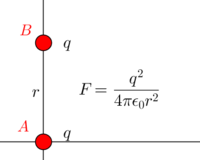Magnetic Force in a Moving Reference Frame: Difference between revisions
No edit summary |
No edit summary |
||
| Line 12: | Line 12: | ||
First: | First: | ||
Electric force is easily calculated by calculating the electric field, <math>{\vec{E}_{top}}</math>, at the location of proton<math>_{bottom}</math>. The equation for electric force is | Electric force is easily calculated by calculating the electric field, <math>{\vec{E}_{top}}</math>, at the location of proton<math>_{bottom}</math>. The equation for electric force is | ||
<math>{\vec{F}_{E,bottom}} = q_{bottom}{\vec{E}_{top}</math>. | <math>{\vec{F}_{E, bottom}} = q_{bottom}{\vec{E}_{top}}</math>. | ||
Therefore: | |||
<math>{\vec{F}_{E, bottom}} = {\frac{1}{4πϵ_0}}{\frac{e^{2}}{r^{2}}}</math>. | |||
Second: | |||
Determine magnetic force. <math>{\vec{F}_{M, bottom}}</math> by calculating the magnetic field <math>{\vec{B}_{top}}</math>. | |||
<math>{\vec{B}_{top}} = {\frac{\mu}{4\pi}}</math> | |||
===A Computational Model=== | ===A Computational Model=== | ||
Revision as of 16:36, 6 December 2015
The Main Idea
The magnetic force of a moving charge depends on the velocity of the charge, and thus can differ according to different moving reference frames.
A Mathematical Model
Let's consider two moving protons to simplify the case. Suppose the two protons are initially traveling parallel to each other with the the same speed. The speed is v, and the two particles are distance, r, apart.

How would we find the electric and magnetic force that the top proton exerts on the bottom?
First: Electric force is easily calculated by calculating the electric field, [math]\displaystyle{ {\vec{E}_{top}} }[/math], at the location of proton[math]\displaystyle{ _{bottom} }[/math]. The equation for electric force is [math]\displaystyle{ {\vec{F}_{E, bottom}} = q_{bottom}{\vec{E}_{top}} }[/math]. Therefore: [math]\displaystyle{ {\vec{F}_{E, bottom}} = {\frac{1}{4πϵ_0}}{\frac{e^{2}}{r^{2}}} }[/math].
Second: Determine magnetic force. [math]\displaystyle{ {\vec{F}_{M, bottom}} }[/math] by calculating the magnetic field [math]\displaystyle{ {\vec{B}_{top}} }[/math]. [math]\displaystyle{ {\vec{B}_{top}} = {\frac{\mu}{4\pi}} }[/math]
A Computational Model
How do we visualize or predict using this topic. Consider embedding some vpython code here Teach hands-on with GlowScript
Examples
Be sure to show all steps in your solution and include diagrams whenever possible
Simple
Middling
Difficult
Connectedness
- How is this topic connected to something that you are interested in?
This topic is interesting because it can be confusing exactly what causes a magnetic force when both the object in question and the reference frame is in motion. The changes in magnetic and electric field due to a change in the reference frame is interesting to note.
- How is it connected to your major?
As a BME it is important to be able to understand the consequences or benefits of looking at a phenomenon in a different angle. However, it is important to note that there is only one force resulting from the magnetic and electric fields. Additionally, magnetic forces would be beneficial when dealing with development of devices including current-carrying wires.
- Is there an interesting industrial application?
Magnetic forces on current-carrying wires are usually larger than the electric force on the same wire, because the net charge is zero. Moreover, when the speed of the particle is less than the speed of light there is less magnetic interaction between 2 charged particles. When the speed exceeds the speed of light, magnetic force between two charged particles can be compared to the electric force.
History
Put this idea in historical context. Give the reader the Who, What, When, Where, and Why.
See also
Further reading
American Physical Society [1]
External links
Michigan State University: Moving Reference Frames[2]
University of Melbourne: Why do Magnetic Forces Depend on Who Measures Them?[3]
References
http://dx.doi.org/10.1103/PhysRevLett.111.160404
https://www.pa.msu.edu/courses/2000fall/PHY232/lectures/magforces/frames.html
http://www.ph.unimelb.edu.au/~dnj/teaching/160mag/160mag.htm